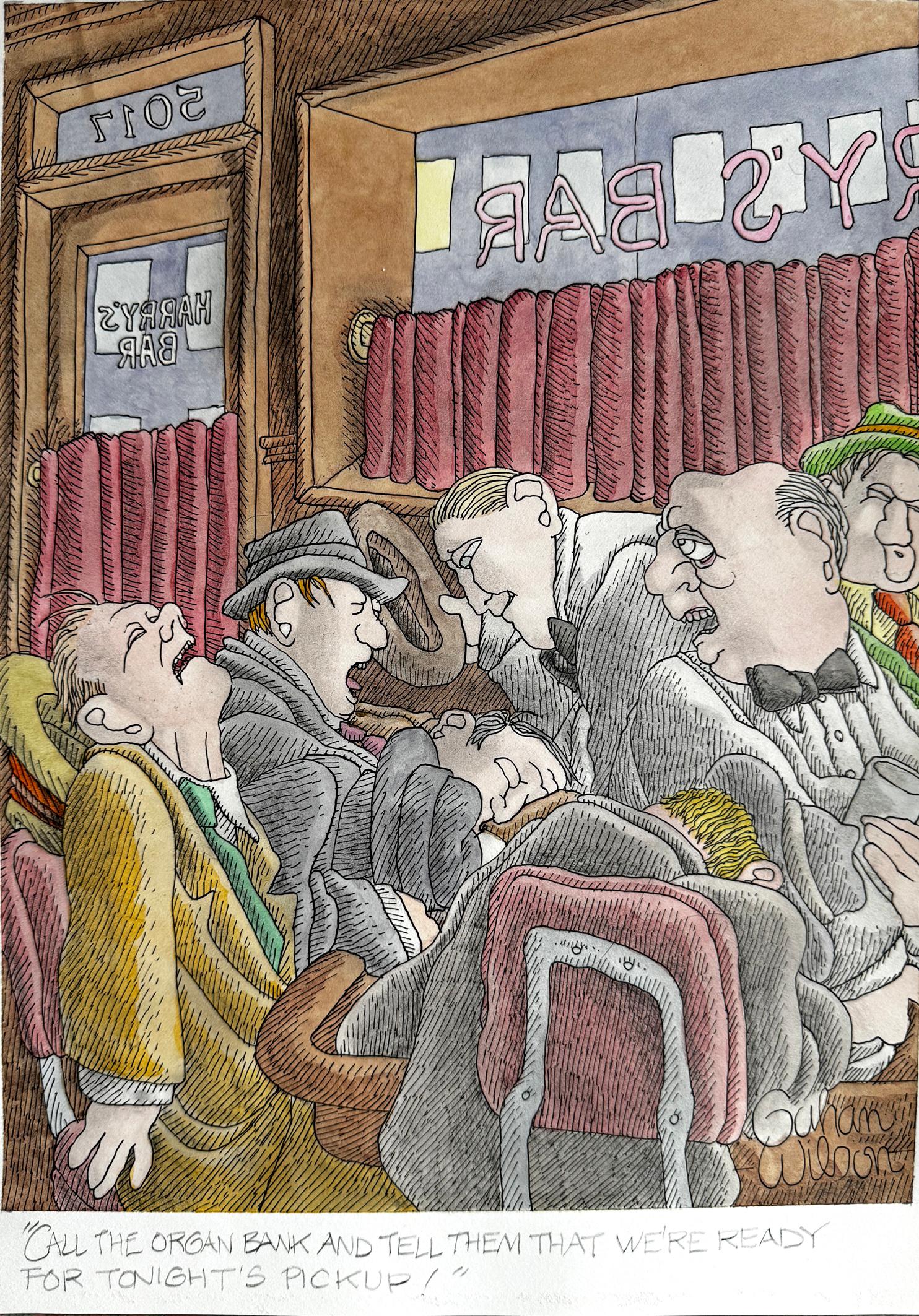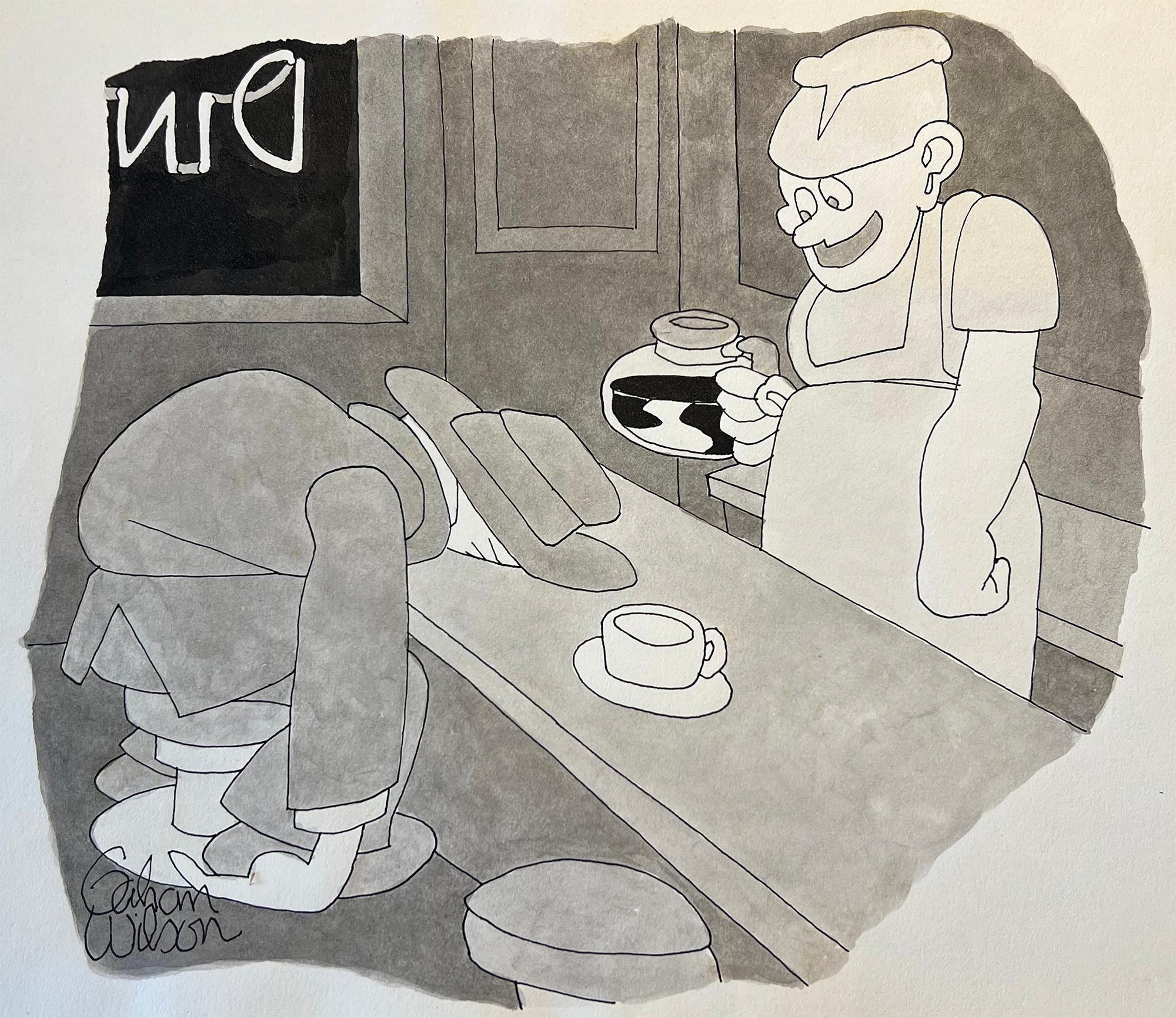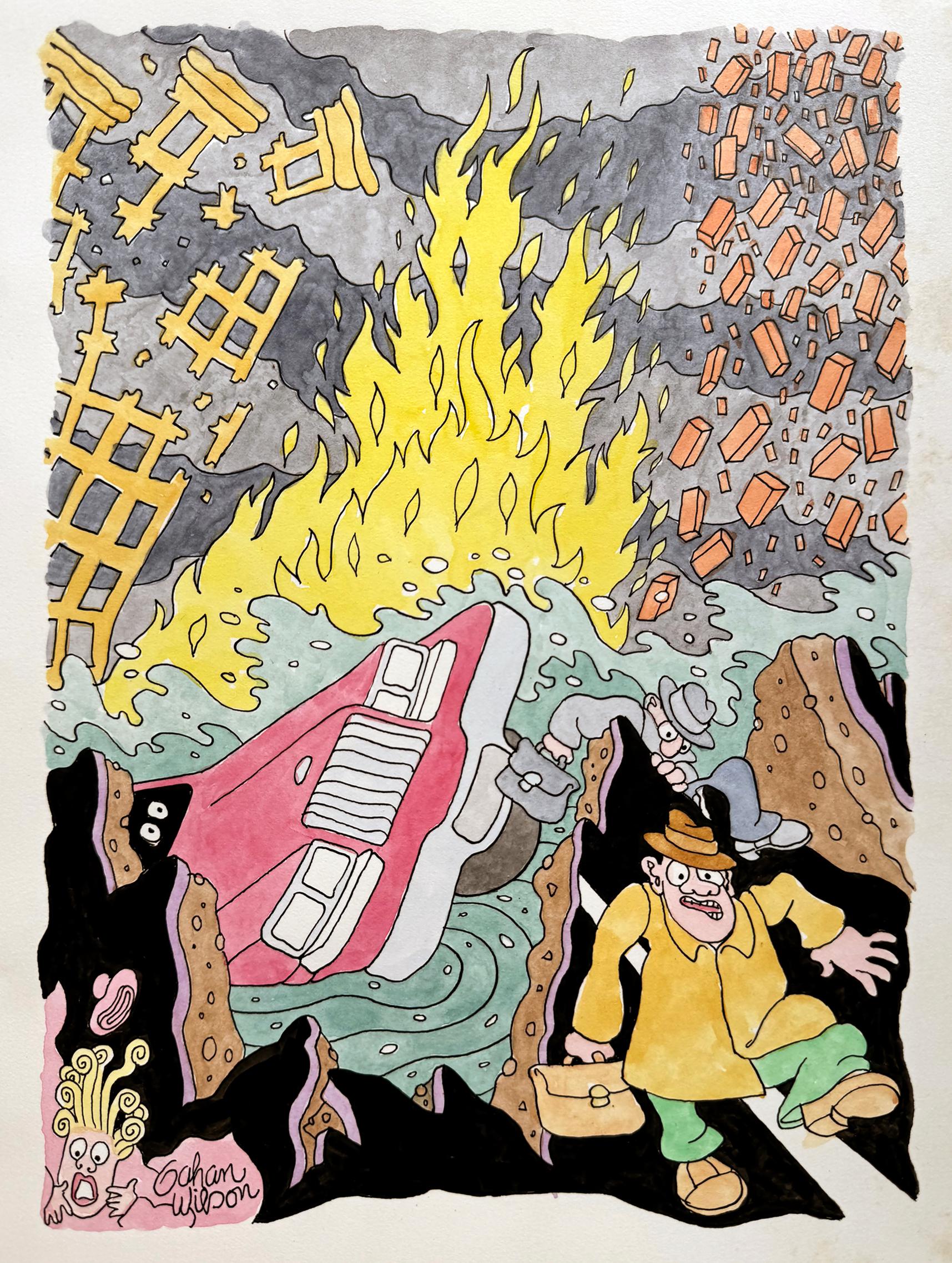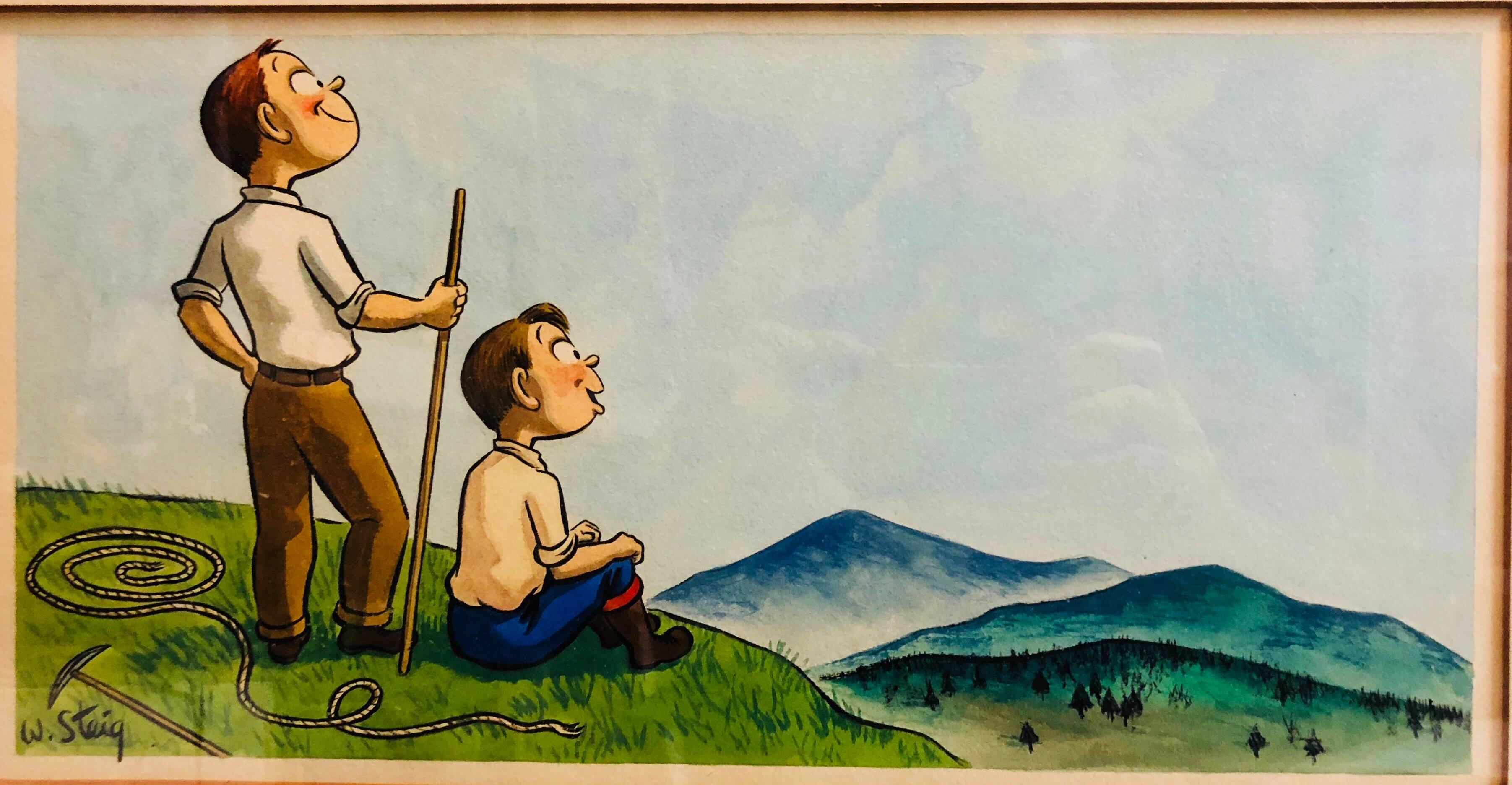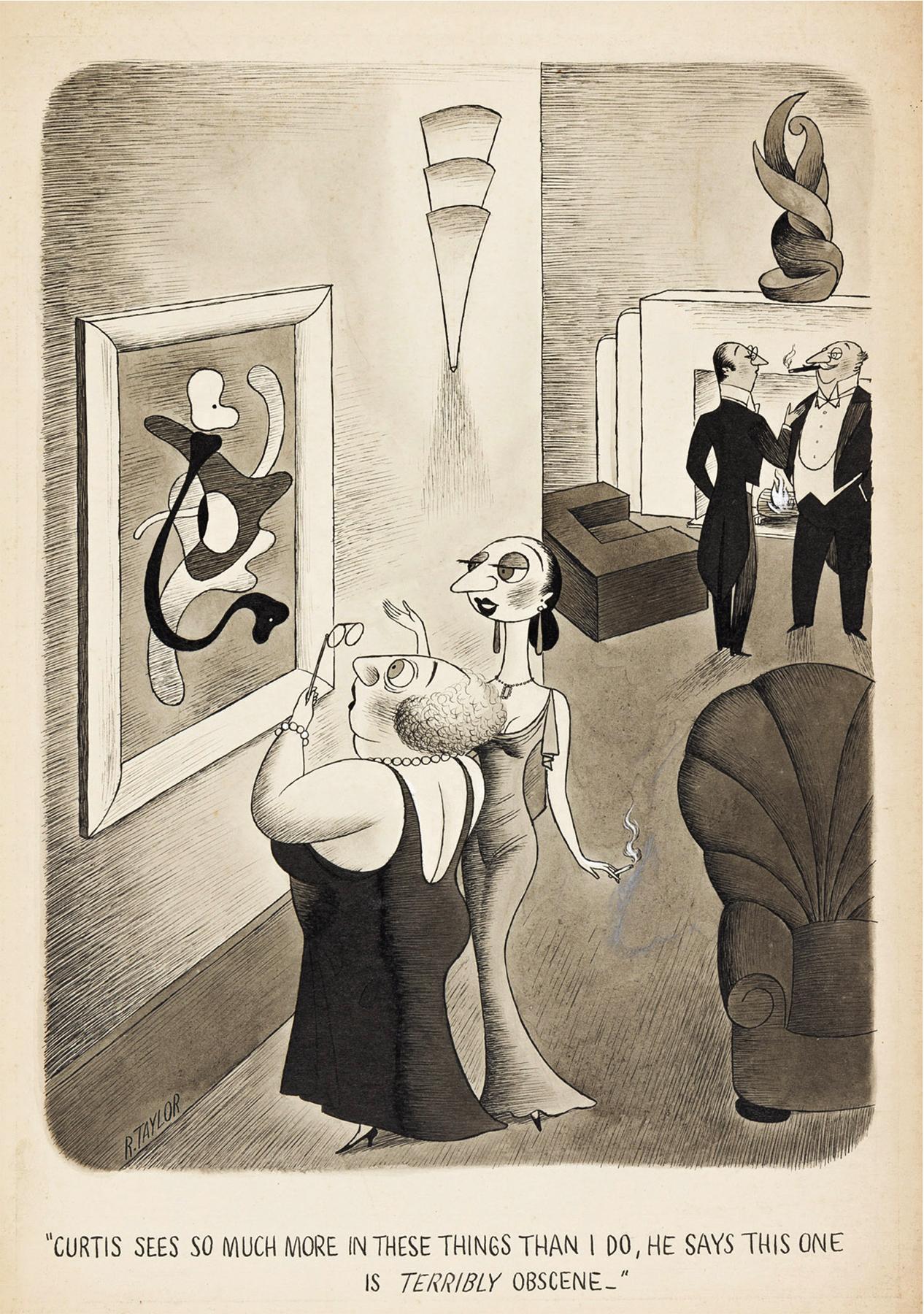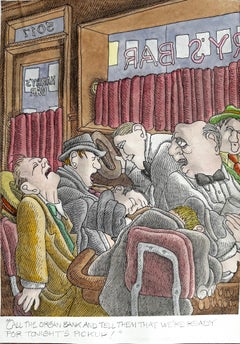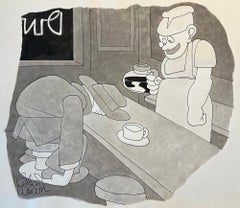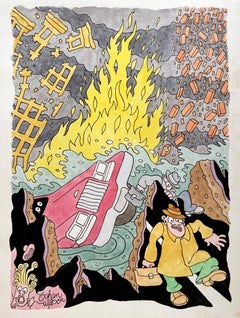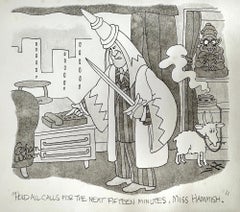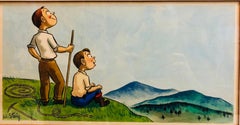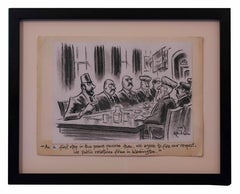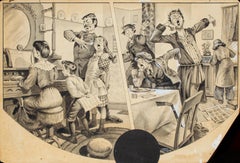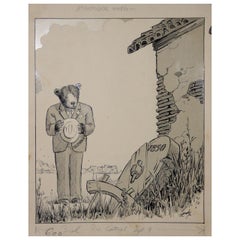Items Similar to Nonconformist Removed by the State. Satyr / Pan Mythology
Video Loading
Want more images or videos?
Request additional images or videos from the seller
1 of 16
Charles Addams Nonconformist Removed by the State. Satyr / Pan Mythology1958
1958
$28,000
£21,130.83
€24,191.61
CA$39,489.28
A$43,354.31
CHF 22,618.03
MX$524,647.49
NOK 283,481.96
SEK 267,114.54
DKK 180,583.88
About the Item
This cartoon by Charles Addams is generations ahead of its time.
To get the punch line, the viewer must know the meaning of a Satyr or Pan.
Satyr: Part man and part beast. - A male nature spirit with ears and a tail resembling those of a horse, as well as a permanent, exaggerated permanent erection. Early artistic representations sometimes include horse-like legs; Satyrs were characterized by their vulgar, indecent ribaldry and were rowdy lovers of wine, music, dancing, and women. They inhabited remote locales, such as woodlands, and they often attempted to seduce or rape nymphs and mortal women alike.
It was prudish 1950s America, and TV programs showed husband and wife sleeping in separate beds. The discussion and representation of sex were repressed. To make a bold statement about censorship and the uncompromising moral climate of the time, Addams uses a reference from the mythical world to make a statement about the real world. In doing so, he anticipates the sexual revolution of the late 1960s and 1970s.
The satyr/pan symbolizes nonconformism. He has his earthy urges, customs, attitudes and ideas. Because of that, he is being handcuffed and formally taken away by the state, whose goal is to repress the natural erotic fun and frolic that is ubiquitous in today's society.
A proper and perfectly pressed Park Ranger removes a lustful undesirable from pristine woodlands. With startled expressions, a vulnerable family of correct women witnesses the event as they are about to have a picnic. The Satyr grasps his Pipes of Pan just over his crotch. Phallic symbols populate the background. This is one of the rare instances where Addams addresses the issue of sex. The Ranger is a dead ringer and a self-portrait of Addams.
This drawing first appeared on page 76 of the June 1958 issue of Holiday magazine. It was subsequently published on page 28 of Black Maria, an Addams compilation book published by Simon & Schuster in 1960. We are indebted to H. Kevin Miserocchi of the Tee & Charles Addams Foundation for this information.
The work has been recently reframed in a new pristine high-end frame with double matting and museum glass.
Framed size: 21 x 24
- Creator:Charles Addams (1912 - 1988)
- Creation Year:1958
- Dimensions:Height: 16.8 in (42.68 cm)Width: 13.75 in (34.93 cm)Depth: 1 in (2.54 cm)
- Medium:
- Movement & Style:
- Period:
- Condition:Conservation on the work to repair a fold but now is not visible and presents very well with snappy color and freshness - Elegantly framed with the highest archival materials.
- Gallery Location:Miami, FL
- Reference Number:1stDibs: LU385313484622
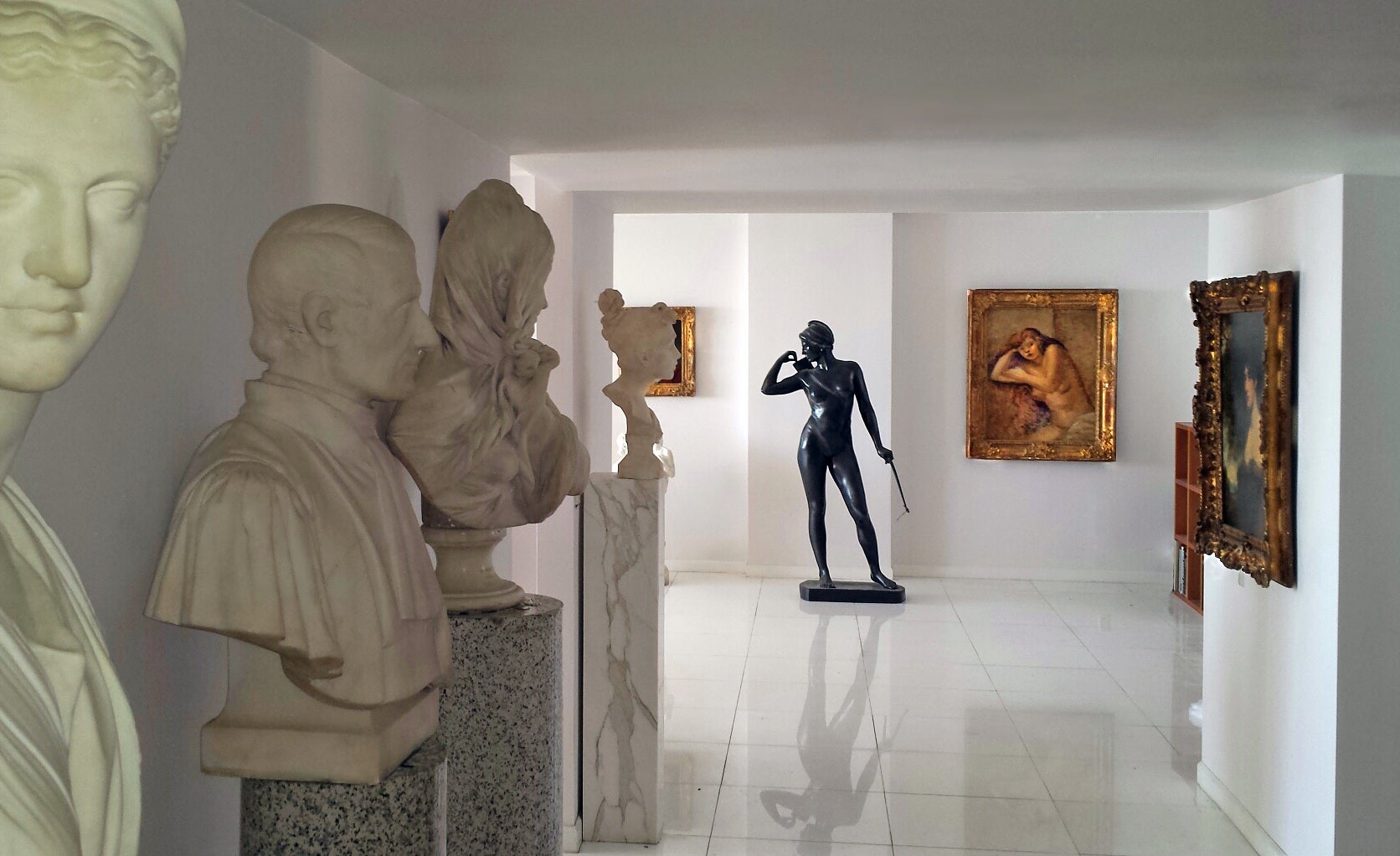
About the Seller
5.0
Gold Seller
Premium sellers maintaining a 4.3+ rating and 24-hour response times
Established in 2005
1stDibs seller since 2016
117 sales on 1stDibs
Typical response time: 1 hour
- ShippingRetrieving quote...Shipping from: Miami, FL
- Return Policy
Authenticity Guarantee
In the unlikely event there’s an issue with an item’s authenticity, contact us within 1 year for a full refund. DetailsMoney-Back Guarantee
If your item is not as described, is damaged in transit, or does not arrive, contact us within 7 days for a full refund. Details24-Hour Cancellation
You have a 24-hour grace period in which to reconsider your purchase, with no questions asked.Vetted Professional Sellers
Our world-class sellers must adhere to strict standards for service and quality, maintaining the integrity of our listings.Price-Match Guarantee
If you find that a seller listed the same item for a lower price elsewhere, we’ll match it.Trusted Global Delivery
Our best-in-class carrier network provides specialized shipping options worldwide, including custom delivery.More From This Seller
View AllMacabre Bar Scene - School of Charles Addams - Playboy Cartoon
Located in Miami, FL
Even without the punch line, Gahan Wilson's highly stylized paintings are marvelous to behold. He is one of a few artists with a unique style instantly re...
Category
Early 2000s Contemporary Figurative Paintings
Materials
Paper, Ink, Watercolor, Pen
How About a Little More Coffee, New Yorker Cartoon
Located in Miami, FL
Interpretation 1: An utterly exhausted man collapses face-first into a diner's countertop. His face and the countertop become one. Seemingly oblivious to the acute nature of the man's condition, the night server gleefully offers him coffee instead of more appropriate help. Interpretation 2: The night server/psycho killer pours unsuspecting customer poisoned coffee and then taunts his lifeless body in a victorious tone. Like Charles Addams...
Category
1990s Modern Figurative Drawings and Watercolors
Materials
Ink, Watercolor
"Still, You Gotta Admit Crime is Down" - New Yorker Cartoon
Located in Miami, FL
Gahan Wilson was a Conceptual Artist who was also a Cartoonist.
The present work was considered as a cover for the New Yorker Magazine for the Jan, 9, 1998 issue. It made it up to th...
Category
1990s Surrealist Landscape Drawings and Watercolors
Materials
Paper, Ink, Mixed Media, Watercolor
Macabre Sacrifice in the Office - New Yorker Cartoon Dark Humor
Located in Miami, FL
Gahan Wilson's artistic output of original ideas, masterfully executed, seems endless. He has a conceptual style that, like Charles Addams, delves into the macabre. Yet, one immedia...
Category
2010s American Realist Figurative Drawings and Watercolors
Materials
Ink, Paper, Pen
Art Lovers and Art Critics Analyzing Obscene Painting. Cartoon
By Richard Taylor
Located in Miami, FL
Cartoonist Richard Taylor was trained in academic art. He frequently comments on abstract art which was the new and radical thing at the time. "Curtis sees so much more in these thi...
Category
1940s Academic Portrait Drawings and Watercolors
Materials
Ink, Board
Wish Not to Be Disturbed for the Duration of Winter - Playboy Cartoon
Located in Miami, FL
Gahan Wilson was the Master of the macabre, and most of his work is associated with Charles Addams. The beauty of a Gahan Wilson is that is a payoff pu...
Category
1960s Conceptual Figurative Paintings
Materials
Ink, Gouache, Color Pencil
You May Also Like
Whimsical Illustration Hiking Cartoon, 1938 Mt Tremblant Ski Lodge William Steig
By William Steig (b.1907)
Located in Surfside, FL
Lighthearted Illustration of Outdoor Pursuits This one being cross country hiking signed "W. Steig"
Provenance: from Mrs. Joseph B. Ryan, Commissioned by Joe Ryan for the bar at his ski resort, Mount Tremblant Lodge, in 1938.
Mont Tremblant, P.Q., Canada
Watercolor and ink on illustration board, sights sizes 8 1/2 x 16 1/2 in., framed.
In 1938 Joe Ryan, described as a millionaire from Philadelphia, bushwhacked his way to the summit of Mont Tremblant and was inspired to create a world class ski resort at the site. In 1939 he opened the Mont Tremblant Lodge, which remains part of the Pedestrian Village today. This original illustration is on Whatman Illustration board. the board measures 14 X 22 inches. label from McClees Galleries, Philadelphia, on the frame backing paper.
William Steig, 1907 – 2003 was an American cartoonist, sculptor, and, in his later life, an illustrator and writer of children's books. Best known for the picture books Sylvester and the Magic Pebble, Abel's Island, and Doctor De Soto, he was also the creator of Shrek!, which inspired the film series of the same name. He was the U.S. nominee for both of the biennial, international Hans Christian Andersen Awards, as a children's book illustrator in 1982 and a writer in 1988.
Steig was born in Brooklyn, New York in 1907, and grew up in the Bronx. His parents were Polish-Jewish immigrants from Austria, both socialists. His father, Joseph Steig, was a house painter, and his mother, Laura Ebel Steig, was a seamstress who encouraged his artistic leanings. As a child, he dabbled in painting and was an avid reader of literature. Among other works, he was said to have been especially fascinated by Pinocchio.He graduated from Townsend Harris High School at 15 but never completed college, though he attended three, spending two years at City College of New York, three years at the National Academy of Design and a mere five days at the Yale School of Fine Arts before dropping out of each.
Hailed as the "King of Cartoons" Steig began drawing illustrations and cartoons for The New Yorker in 1930, producing more than 2,600 drawings and 117 covers for the magazine. Steig, later, when he was 61, began writing children's books. In 1968, he wrote his first children's book. He excelled here as well, and his third book, Sylvester and the Magic Pebble (1969), won the Caldecott Medal. He went on to write more than 30 children's books, including the Doctor DeSoto series, and he continued to write into his nineties. Among his other well-known works, the picture book Shrek! (1990) formed the basis for the DreamWorks Animation film Shrek (2001). After the release of Shrek 2 in 2004, Steig became the first sole-creator of an animated movie franchise that went on to generate over $1 billion from theatrical and ancillary markets after only one sequel. Along with Maurice Sendak, Saul Steinberg, Ludwig Bemelmans and Laurent de Brunhofff his is one of those rare cartoonist whose works form part of our collective cultural heritage.
In 1984, Steig's film adaptation of Doctor DeSoto directed by Michael Sporn was nominated for the Academy Award for Best Animated Short Film. As one of the most admired cartoonists of all time, Steig spent seven decades drawing for the New Yorker magazine. He touched generations of readers with his tongue–in–cheek pen–and–ink drawings, which often expressed states of mind like shame, embarrassment or anger. Later in life, Steig turned to children's books, working as both a writer and illustrator.
Steig's children's books were also wildly popular because of the crazy, complicated language he used—words like lunatic, palsied, sequestration, and cleave. Kids love the sound of those words even if they do not quite understand the meaning. Steig's descriptions were also clever. He once described a beached whale as "breaded with sand."
Throughout the course of his career, Steig compiled his cartoons and drawings into books. Some of them were published first in the New Yorker. Others were deemed too dark to be printed there. Most of these collections centered on the cold, dark psychoanalytical truth about relationships. They featured husbands and wives fighting and parents snapping at their kids. His first adult book, Man About Town, was published in 1932, followed by About People, published in 1939, which focused on social outsiders. Sick of Each Other, published in 2000, included a drawing depicting a wife holding her husband at gunpoint, saying, "Say you adore me."
According to the Los Angeles Times, fellow New Yorker artist Edward Sorel...
Category
1930s Naturalistic Figurative Drawings and Watercolors
Materials
Archival Ink, Watercolor, Illustration Board
Ed Fisher (1926-2013) Original Cartoon Drawing From "The New Yorker"
Located in San Francisco, CA
Ed Fisher (1926-2013) Original Cartoon
From "The New Yorker"
Circa 2009
Graphite on Paper
9" x 12.5" unframed
12" x 16" framed
Category
Early 2000s Figurative Drawings and Watercolors
Materials
Graphite
Rockwellian Style Watercolor by WW2 Illustrator Carol Johnson
Located in New York, NY
Carol Johnson (American, c. 1917-2003)
Untitled (American Family), c. 1950
Watercolor and paper mounted to board
13 5/8 x 23 inches
Signed lower right: C...
Category
1950s American Modern Figurative Drawings and Watercolors
Materials
Paper, Mixed Media, Watercolor, Board
Fred Lundy CA Great Depression Cartoon Illustration, circa 1938
Located in San Francisco, CA
Rare original cartoon illustration by listed American cartoonist Fred Lundy.
Fred Ralph Lundy (1902-1989) studied art at the University of Oregon before moving to California in 1924. Following further study at the CCAC, he was an artist with the Oakland Tribune from 1935-1935 and an editorial cartoonist for the San Francisco Examiner from 1935 until retirement in 1976. His cartoons appeared in Saturday Evening Post, Colliers, Esquire, New Yorker, and other national magazines. He died in Daly City...
Category
Early 20th Century American Drawings
Materials
Paper
The Thinker? —vintage drawing, original 'Superman' artist
By Leonard Nowak
Located in Myrtle Beach, SC
Leonard Nowak, 'The Thinker?', conté crayon and India ink, c. 1940s. Signed in ink, lower left. Original cartoon drawing, on textured, off-white wove dra...
Category
1940s Modern Figurative Drawings and Watercolors
Materials
Conté, India Ink
Original Illustration from Famous Artists Course
By Peter Helck
Located in Fort Washington, PA
Medium: Ink and Wash on Paper
Signature: Signed Lower Right
Category
20th Century Figurative Drawings and Watercolors
Materials
Paper, Ink
More Ways To Browse
Holiday Magazine
Mythology Painting
Vintage Compilation
Satyr Painting
Nonconformist Art
1950s Televisions
1950s Tv
Satyr Pan
1950s Vintage Television
The Satyr Paintings
17th Century Italian Drawings
Benjamin Lee
Cain Modern Art
Givenchy Drawing
Pencil Angels
Rex Whistler
Vintage Mark Twain
1950s Female Nude Painting
